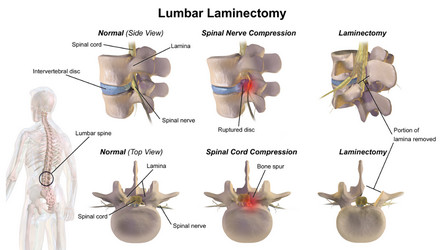Is Lumbar Laminectomy/Discectomy Considered a Safe Procedure?
Understanding Lumbar Laminectomy and Discectomy
A lumbar laminectomy is a surgical procedure that involves removing a portion of the vertebral bone called the lamina in the lower back (lumbar) region of the spine. This procedure is often combined with a discectomy, which involves removing part of a herniated or damaged disc. The primary goal of these procedures is to relieve pressure on the spinal nerves, alleviating pain and other symptoms associated with conditions like spinal stenosis or herniated discs. By creating more space for the nerves, these surgeries aim to improve a patient’s quality of life and mobility.
Safety and Effectiveness
Lumbar laminectomy and discectomy are generally considered safe and effective procedures, particularly when performed by an experienced surgeon for the right indications. These surgeries are commonly used to treat conditions such as herniated discs, spinal stenosis, and nerve compression in the lower back, offering relief to patients who have not found success with conservative treatments.
Potential Risks and Complications
While all surgical procedures carry some level of risk, complications from lumbar laminectomy and discectomy are relatively low. Potential complications can include infection, bleeding, or nerve damage, but these are rare occurrences. It’s important for patients to discuss these risks with their surgeon and understand how they apply to their case.
Recovery Time and Minimally Invasive Techniques
One of the advantages of these procedures is the relatively quick recovery time compared to more invasive spinal surgeries. Most patients can resume normal activities within 4-6 weeks post-surgery. Additionally, many lumbar laminectomies and discectomies can now be performed using minimally invasive techniques. These advanced methods typically result in smaller incisions, reduced blood loss, and faster recovery times, further enhancing the safety profile of the procedures.
Effectiveness for Specific Conditions
The effectiveness of lumbar laminectomy and discectomy is most pronounced in patients with specific conditions, such as nerve root compression due to a herniated disc or spinal stenosis. However, it’s worth noting that these procedures may be less effective for generalized lower back pain without nerve involvement. To ensure the best possible outcome, it’s crucial for patients to follow post-operative care guidelines, including prescribed physical therapy and activity modifications.
Long-Term Considerations
While these procedures are highly effective at relieving symptoms, it’s important to understand that they do not stop the underlying degenerative processes that may have caused the initial condition. Some patients may develop additional spinal issues over time, which is why ongoing care and maintenance of spinal health is important.
Recovery Process and Return to Activities
The recovery process varies from patient to patient. While most can return to light activities within 4-6 weeks, those involved in high-impact sports, heavy lifting, or jobs requiring strenuous physical labor may need a longer recovery period. In some cases, long-term restrictions might be necessary to prevent future injury. It’s also worth noting that while many patients regain full function, some may experience residual symptoms such as mild pain or stiffness.
Conclusion
Overall, lumbar laminectomy and discectomy have established themselves as safe and effective procedures with a strong track record. They offer a viable solution for many patients suffering from certain types of lower back and leg pain. However, the decision to undergo surgery should always be made in consultation with a qualified healthcare professional, taking into account the individual patient’s specific condition, overall health, and lifestyle factors.
In conclusion, while lumbar laminectomy and discectomy often restore the ability to engage in most daily and recreational activities, a full return to all pre-surgery activities, especially strenuous ones, depends on individual circumstances and careful adherence to recovery protocols. These procedures have helped countless patients regain their quality of life, making them valuable tools in the treatment of specific spinal conditions.

